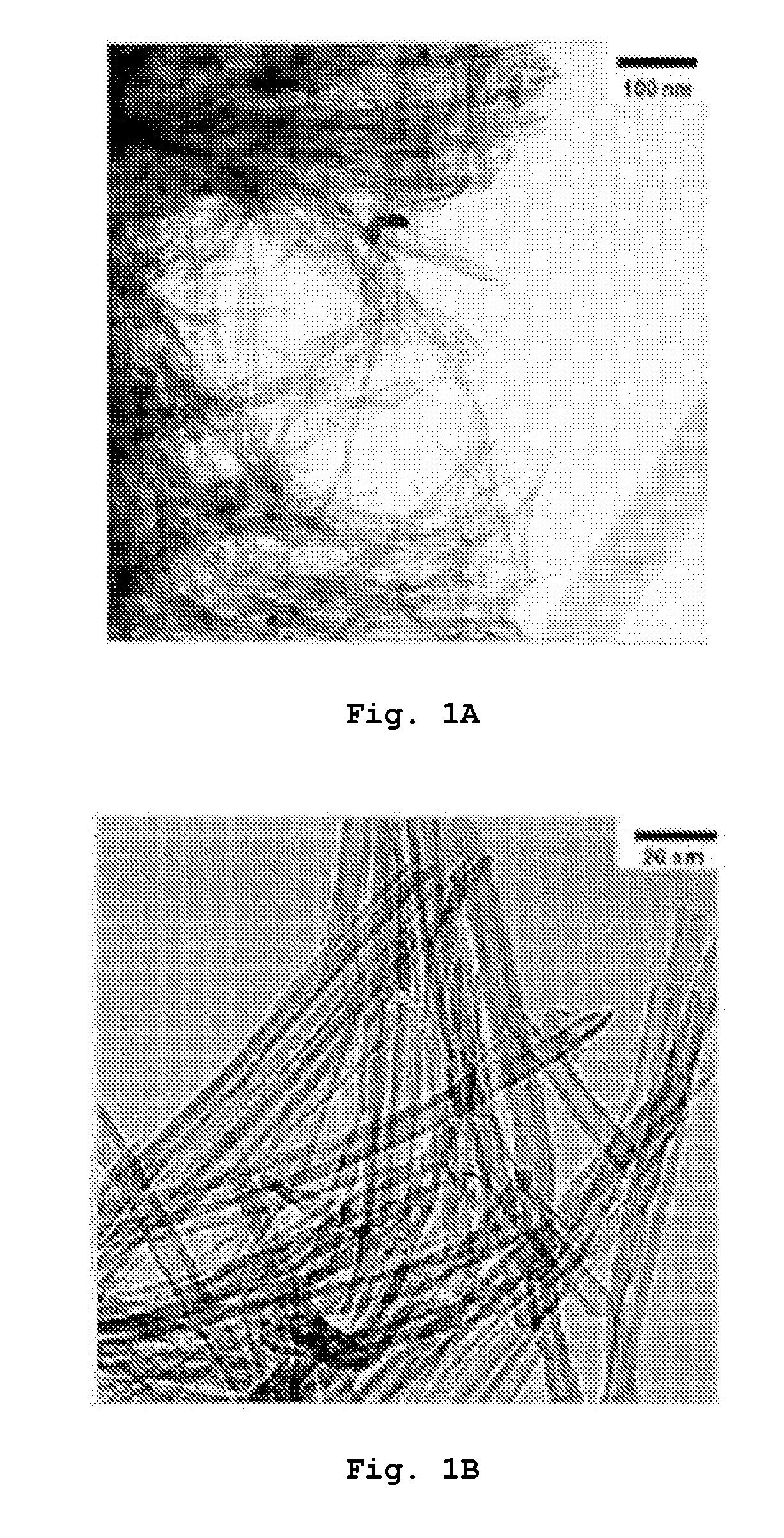Titanate Nanostructure and Method for Preparation Thereof
a technology of titanium nanotubes and nanotubes, which is applied in the field of titanium nanotubes, can solve the problems of threatening human life, fossil fuel deposits may be almost exhausted in not more than 50 to 100 years, and cannot be recycled after use, so as to achieve enhanced hydrogen uptake capacity, effective use, and high capacity
- Summary
- Abstract
- Description
- Claims
- Application Information
AI Technical Summary
Benefits of technology
Problems solved by technology
Method used
Image
Examples
experimental example 1
[0032]In order to investigate forms of the titanate nanostructures prepared according to the foregoing preparative examples 1 to 3, a TEM analysis was performed.
[0033]FIG. 1A is a TEM photograph and FIG. 1B is an enlarged TEM photograph illustrating the titanate nanostructure prepared according to Preparative Example 1.
[0034]As shown in FIG. 1A, the titanate nanostructure in Preparative Example 1 was nanotube and was aggregated in a spherical bundle form. Each of the nanotubes had a length of about 500 nm. As shown in FIG. 1B, a plurality of nanotubes having a diameter of about 5 nm were overlapped into 3 to 4 layers.
[0035]FIG. 2A is a TEM photograph and FIG. 2B is an enlarged TEM photograph illustrating the titanate nanostructure prepared according to Preparative Example 2. As shown in FIG. 2A, the titanate nanostructure in Preparative Example 2 was nanowire and each of the nanowires had a diameter of about 7 nm and a length of several μm. As shown in FIG. 2B, a plurality of nanowi...
experimental example 2
[0038]In order to analyze the titanate nanostructure NaKTi3O7 prepared according to Preparative Example 3, an XRD analysis was performed as shown in FIG. 4.
[0039]From results of the XRD analysis shown in FIG. 4, it can be seen that the titanate nanostructure has all of three phases such as K2Ti8O17, Na2Ti6O13 and TiO2. This result demonstrates that different alkaline metals, that is, sodium Na and potassium K co-exist between titanate nanostructure layers.
experimental example 3
[0040]In order to analyze a volume of micropores in each of the titanate nanostructures prepared according to Preparative Examples 1 and 3 by Horvath-Kawazoe (HK) process, a Brunauer-Emmett-Teller (BET) analysis was performed and results thereof are shown in FIG. 5. Referring to FIG. 5, a graph for Na2Ti3O7 nanotubes demonstrates the titanate nanostructure in Preparative Example 1 while a graph for NaKTi3O7 nanotubes demonstrates the titanate nanostructure in Preparative Example 3.
[0041]As shown in FIG. 5, if a pore width is about 6, the micropore volume of the titanate nanostructure (NaKTi3O7 nanotubes) in Preparative Example 3 was larger than that of the titanate nanostructure (Na2Ti3O7 nanotubes) in Preparative Example 1. The reason for such results is presumed that the titanate nanostructure in Preparative Example 3 has a length shorter than that of the titanate nanostructure in Preparative Example 1, thus exhibiting relatively large surface area.
PUM
| Property | Measurement | Unit |
|---|---|---|
| temperature | aaaaa | aaaaa |
| pH | aaaaa | aaaaa |
| length | aaaaa | aaaaa |
Abstract
Description
Claims
Application Information
 Login to View More
Login to View More - R&D
- Intellectual Property
- Life Sciences
- Materials
- Tech Scout
- Unparalleled Data Quality
- Higher Quality Content
- 60% Fewer Hallucinations
Browse by: Latest US Patents, China's latest patents, Technical Efficacy Thesaurus, Application Domain, Technology Topic, Popular Technical Reports.
© 2025 PatSnap. All rights reserved.Legal|Privacy policy|Modern Slavery Act Transparency Statement|Sitemap|About US| Contact US: help@patsnap.com



